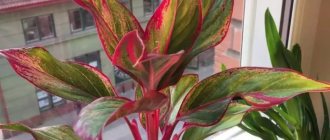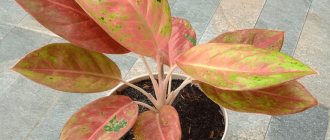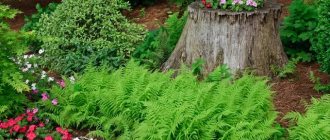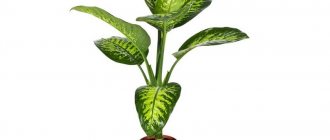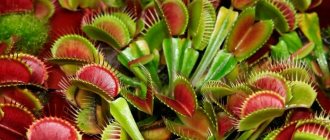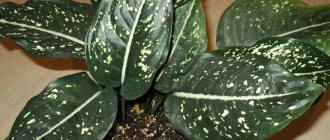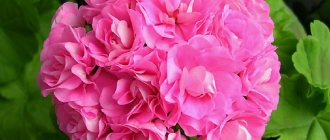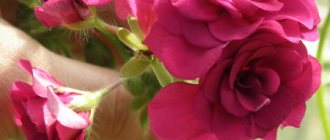The decorative foliage flower Aglaonema is native to India. In nature, it grows in the lower tier of forests and along river banks. The flower is a relative of Dieffenbachia and a useful houseplant. It destroys streptococcal infection and effectively cleans the air of harmful substances. A shade-loving plant with colorful foliage will decorate many corners of the house.
What does aglaonema look like?
The flower's appearance resembles a small bush 0.25-1 m high with a short straight stem and tightly fitting long fleshy leaves. They can be different shades of green and, less often, red (depending on the variety), with white, pink, silver, yellow streaks and spots. The green pet blooms with small cobs, which are strewn with pale green, pink or white small rosettes. The fruits are ruby or orange oblong berries, sometimes white, with one seed inside, suitable for sowing.
How can aglaonema reproduce?
Reproduction of aglaonema does not present any particular difficulties. There are three ways: seeds, cuttings and root division. Aglaonema is not propagated by leaves.
Seeds
This method is suitable for those gardeners who love surprises. The fact is that plants grown from seeds often do not resemble their parents. You can collect seeds only when they are easily separated from the fruit at the slightest touch. If you need to make an effort to remove the seeds, it means they are not yet ripe. Seeds must be planted immediately.
Process description:
- A mixture of peat and river sand in equal proportions is poured into wide flat pots or boxes; sphagnum moss is also suitable.
- The seeds are not deeply buried - a maximum of 1.5 centimeters into moist soil.
- The planting container is covered with polyethylene or glass.
- Every 2-3 days the soil is sprayed with a spray bottle.
- Under favorable conditions, the first shoots appear after 3 months.
- After a pair of true leaves appear, the aglaonema can be transplanted into a separate pot.
Cuttings
As cuttings, you can use apical, lateral shoots of aglaonema or parts of the bare trunk of an adult plant that have growing points. The length of the cutting should be at least 3–5 centimeters, and the presence of at least one leaf guarantees almost 100% rooting.
Rooting parts of the trunk can be done all year round, but it is best to do this in March-April.
- Powder the chopped parts of the trunk with crushed activated carbon and dry for a day.
- We lightly press a piece of the trunk into the wet substrate, if it is small, and if the piece is larger, we deepen it vertically to the growth point.
- Cover with a plastic bag and place in a warm, bright place.
- The temperature should be from +24 to +26 degrees. You need to ventilate the cuttings once a day, slightly lifting the bag. Keep the soil moist.
- In a month, roots will appear.
Rooting of apical or lateral shoots occurs as follows:
- We cut off the shoots and tie the leaves on them into a bundle to reduce moisture evaporation.
- We dip them for a few minutes in a solution of Epin or Zircon for better root formation (you don’t have to do this, aglaonema usually takes root well without this procedure).
- Sprinkle the sections with crushed activated carbon and dry for 8 hours.
- Prepare the pot: pour drainage and soil in half with sand. We moisturize well.
- Using a pencil or stick, make a hole in the ground.
- We plant the cutting to the base of the leaf, compacting the soil around it.
- Using a frame and cellophane we make a greenhouse.
- Place in a warm, bright place. Ventilate periodically.
- Don't forget to moisten the soil as it dries.
- In a month, the aglaonema will have a root system.
Dividing rhizomes
An adult, heavily grown plant, which is divided into several bushes, is best suited for this method.
- Remove the aglaonema from the pot.
- Shake off excess soil and wash the roots in water.
- Using a sharp knife or scissors, separate the young shoots with a formed root system.
- Sprinkle the cut areas with activated carbon, crushed into powder.
- Immediately plant the separated shoot in a pot prepared in advance and water well.
- Place in a warm place for a week. Spray periodically.
- When a young leaf appears on the aglaonema, which indicates normal rooting, place the pot with the plant in a permanent place.
Varieties of Aglaonema
Due to the height of the bushes, flower varieties are divided into three groups:
- Short. They have a size of up to 25 cm, creeping or drooping stems;
- Medium height. Their leaf blades grow up to 30 cm in length;
- Tall. They have a size of 1 m and leaves up to 40 cm.
The most famous types of aglaonema with photos:
- "Silver Queen" A flower up to 40 cm high that loves a lot of light, which gives it a special variegation. It has a beautiful silver-blue leaf surface;
- “Crete” (sometimes called red aglaonema) is a plant with brightly colored foliage with pinkish, green, and purple splashes. The variety requires bright lighting. Reaches 30-40 cm in height;
- "Maria". It is a medium-sized crop with dense emerald-colored leaves. This “green resident” is shade-tolerant; even a room with artificial light will suit it;
- "Modest." The bright green plant reaches a height of 50 cm, has pointed leaves, rounded with noticeable veins, which are elongated up to 20 cm;
- “Changable” (another name is “changeable”). It is an upright bush with elongated dark green glossy foliage in the shape of an ellipse, up to 30 cm long. A room with diffused light is well suited for favorable growth.
The best varieties of aglaonema with photos and names
Aglaonema King of Siam or King of Siam King of Siam
Aglaonema King of Siam King of Siam photo
The powerful petioles are quite tall, white, and hold dense dark green leathery leaves with expressive white veins. The bush is compact, densely leafy.
Aglaonema Maria Aglaonema Commutatum Maria
Aglaonema Maria Aglaonema Commutatum Maria photo
The Maria variety is loved due to the very beautiful coloring of the leaves: on a dark green background there are light spots-stripes in a symmetrical herringbone pattern in the direction of the veins. The leaves are elongated, the bush is compact.
Aglaonema Silver Queen Silver Queen
Aglaonema silver queen Silver Queen photo
The stunning colors of the Silver Queen variety, combined with the beautiful shape of the leaf, made the Silver Queen a real queen among all aglaonemas.
Aglaonema Silver Bay Aglaonema Silver Bay
Aglaonema Silver Bay Aglaonema Silver Bay photo
Almost white, with a silvery tint, with dark green outlining strokes along the edges, the leaves of this plant look mesmerizing. You just can’t take your eyes off the Silver Bay variety.
Red Aglaonema Crete Aglaonema Crete
Aglaonema Crete Aglaonema Crete photo
The Crete variety is notable for its rare shade of purplish-red outlining stripes along the edge of the leaf and rare veins. The leaves are elongated, pointed, slightly sinuous, bent inward in the center.
Aglaonema Stripes Aglaonema Stripes
Aglaonema Stripes Aglaonema Stripes photo
A playful striped pattern reminiscent of a zebra will add a fresh touch to any interior. The Stripes variety fits effectively into apartment and office settings.
Aglaonema Maria Christina Aglaonema Commutatum Maria Christina
Aglaonema Maria Christina Aglaonema Commutatum Maria Christina photo
The amazing bluish-silver hue with small dark green spots-stripes along the veins and along the edge of the leaf makes an indelible impression. The Maria Christina variety combines effectively in compositions with dark green and red decorative foliage plants.
Aglaonema Pink Aglaonema Pink
Aglaonema Pink Aglaonema Pink Ruby photo
Pink varieties (pink) are very interesting for their unusual color with small or large dark green spots. The drawings are very diverse, which opens up wide scope for imagination in creating compositions that decorate the interior.
Aglaonema Diamond Bay Aglaonema Diamond Bay
Aglaonema Diamond Bay Aglaonema Diamond Bay photo
The Diamond Bay variety has long, pointed leaves, slightly curled, and has a compact, densely leafy crown. The coloring is also original: dark green around the edges, in the center the leaves have a greenish-silver tint.
Aglaonema AnYaManee
Aglaonema anyamanee photo
The pink variety AnYaManee has earned itself particular popularity, having colorful shades of pink and green with a fancy marble pattern. The leaves are leathery, dense, with a slight gloss.
Aglaonema Sab Mongol
Aglaonema sab Mongol photo
Luxurious leaves with a velvety pattern in rich burgundy and green shades simply captivate the eye. The Sab Mongol variety will decorate any interior, introducing elements of luxury.
Aglaonema Green Lady Aglaonema Green Lady
Aglaonema Green Lady Aglaonema Green Lady photo
The Green Lady variety Aglaonema Green Lady is very impressive thanks to the beautiful shape of the leaves with pointed tips and variegated color, mixing rich green and light green with a silver tint.
Aglaonema Cutlass Aglaonema Cutlass
Aglaonema Cutlass Aglaonema Cutlass photo
A special feature of the Cutlass variety Aglaonema Cutlass is its long narrow leaves, collected in a dense basal rosette, reminiscent of the top of a palm tree. Delicate light green, almost silvery color, set off by dark green veins and edges along the edges of the leaves.
Aglaonema Palace Thailand aglaonema palace thailand
Aglaonema Palace Thailand aglaonema palace thailand photo
No less attractive are the varieties of the Palace series with different shades of color. Ribbed leaves with expressive veins look very impressive.
Planting and growing a flower
It is not recommended to immediately replant a houseplant aglaonema purchased in a store. Let it adapt within 2-3 weeks.
Landing rules:
- Place drainage in the pot - expanded clay, small pebbles, broken shards or nut shells;
- Fill the soil up to 1/2 volume;
- Place the flower in the center of the pot, straighten the roots, add substrate;
- If the plant is young, then there is no need to deepen it, but an adult plant can be planted a little;
- Generously water the crop with warm water.
What can be done to make the flower grow lush and beautiful? You need to know its features:
- The tropical bush loves places with diffused light, as well as slightly shaded ones. Protect it from direct sunlight and do not place it near heating appliances;
- In summer, the temperature should be + 20-25 degrees, in winter – slightly lower;
- The flower prefers warmth and high humidity, so water it twice a week, and especially take this into account in dry weather;
- The culture does not tolerate drafts and does not like to come into contact with tobacco and other smoke.
Benefits and harms of aglaonema in the home
The properties of the houseplant aglaneoma are somewhat contradictory, so before you start growing it, you need to become familiar with both its beneficial qualities and the amount of harm it can cause.
Beneficial features
All types of plants have the ability to cleanse the surrounding space of harmful impurities emitted by furniture, plastic finishing materials, paints and varnishes (for example, benzene). Some varieties successfully fight streptococcal infections.
When aglaonema is actively growing, it releases a large number of air ions. Therefore, in places where aglaonemas grow, a person experiences a surge of strength, increased performance, and increased stability in stressful situations.
Harmful effect
Aglaonema, like all aroids, contains a certain amount of oxalic acid, toxic enzymes and proteins. This combination, if handled incorrectly, can cause severe irritation and even burns to the skin.
The release of plant juice can cause swelling of the mucous membranes and difficulty breathing. In some cases, aglaonema can cause allergic reactions. Therefore, when carrying out any work with the plant, you need to use protective gloves, and when finished, you need to wash your hands well with soap.
When aglaonema finishes flowering, it produces spectacular red berries that also contain toxic substances. Therefore, plants should not be placed where small children can reach them. You also need to prevent pets from interacting with them.
Soil and pot for the plant
In order for a flower to grow healthy and attractive, it is necessary to have nutritious soil. The soil should have good water and air permeability and be loose. If you prepare the soil yourself, then in composition it should consist of: three parts of leaf soil, one part of peat, one part of sand, as well as 1/2 part of charcoal and 1/2 part of humus. You can buy ready-made soil for heather, azaleas or violets. This composition is perfect for our “green friend”.
The root system of the plant is fibrous and superficial, so it does not need a deep pot. An indoor flower has excellent leaf growth and better development is possible if its roots grow in a small container. The ideal option would be a wide (if there are young shoots) and shallow pot, but do not forget that 1/4 of its height must be filled with drainage.
Home care
Before you start growing a flower, you need to study a number of recommendations that will help you figure out how to properly care for aglaonema:
- It is necessary to spray regularly in the summer, and in winter, on the contrary, aglaonema should be kept in a room with a low humidity level;
- The plant needs access to fresh air, but drafts are harmful;
- Aglaonema does not tolerate tobacco smoke;
- The soil should dry well between waterings;
- If the value of aglaonema is decorative foliage, it is necessary to remove the resulting peduncles, since during flowering the leaves grow much smaller in size.
How to care for aglaonema
Caring for aglaonema at home involves regular watering, fertilizing, spraying and timely replanting. To maintain air humidity at the desired level around the pot, it can be placed in a tray with wet pebbles or expanded clay. The leaves of the plant must be frequently wiped or watered from the shower. Then they will not lose their shine and brightness. Let's look at the description of the rules of care in more detail.
Watering aglaonema
Abundant watering of the plant must be done from April to November, when the top layer of soil dries out. But moisture should not be allowed to remain in the root system for a long time. The frequency and abundance of watering is selected based on the temperature of the room - when it is cool, the flower requires less water.
In winter, the amount of moisture is reduced by watering two days after the soil has dried. In summer, it is necessary to water the bush every other day.
Pruning aglaonema
In order for a flower to become bushy, you need to prevent it from blooming and cut off growing shoots with buds. This will lead to the appearance of new buds, and the bush will begin to grow, acquire splendor and beauty.
If during growth the stems become bare and the shoot seems bald, then the top of the trunk on which the voids have appeared is cut off. Soon after this, young leaves and shoots will begin to grow at the cut site. And the cut cuttings can be placed in water or in soil covered with film. After some time it will begin to take root.
Possible problems
Ficus ali: home care, propagation by cuttings, diseases and photos of varieties
When grown in improper conditions, aphids, scale insects and thrips may appear on the plant. When kept dry and low humidity, plants are attacked by spider mites. In addition, the possibility of rotting of the root system or yellowing of the foliage cannot be ruled out.
For preventative purposes, it is necessary to regularly inspect potted plants in order to see the problem in time and eliminate it.
If plants become sick with leaf spot or gray rot, then the diseases must be combated with the use of fungicides.
Aglaonema is a useful indoor plant. Its foliage absorbs harmful substances, in particular benzene. Due to its undemanding requirements for lighting, the plant is used to decorate rooms of varying lighting conditions.
Watch a video about the intricacies of caring for it:
Reproduction of aglaonema
This plant can be propagated in three ways:
- Dividing the bush;
- By cuttings;
- Seeds.
The first method is the easiest to implement. During the April or May transplantation, strong, healthy shoots with 3-4 leaves and roots are carefully plucked from the bush. In this case, the part that should be underground is carefully cut with a sharp knife. The daughter shoot is planted for rooting in a separate container with fertile soil. With regular watering and fertilization, it begins to grow vigorously.
The second method - cuttings, involves cutting the stem with the apical part and dividing the trunk into several more segments of 9-12 cm, each of which should have leaves. The cuttings are dried for a couple of days, the sections are covered with charcoal. Next comes the rooting stage:
- The cuttings are planted to a depth of 5 cm in a mixture of sand and peat;
- Rooting must be done at a temperature of +22-25 degrees. This will help the roots form faster within a month;
- By providing the flower with heating from below, rooting can be carried out at any time of the year. Otherwise, it is better to wait for warm summer time;
- After strengthening the bush, it can be moved to a separate container filled with soil for young plants.
Reproduction by seeds, which emerge from red fruits, is carried out in the summer. It is not worth storing seed material, because it quickly deteriorates and loses its viability.
- Aglaonema seeds are washed and immediately sown in cups with a sand-peat substrate;
- They need to be constantly watered and kept in a warm place;
- Shoots appear quite quickly. When forming leaves, you need to plant the flowers in separate pots;
- Full development of plants occurs after 3-4 years, but varietal characteristics are not always preserved.
You can buy an already mature aglaonema flower in flower shops or in specialized online stores. The cost varies significantly depending on the type. It starts from about 600 rubles and can reach up to 6,000 rubles. You can also purchase the plant from amateur florists, where the price will be significantly lower.
Such a bright tropical bush can serve as a decoration for any home, and its main advantage is its unpretentiousness, which is highly valued by floriculture lovers.
Description of the plant
Aglaonema is a perennial plant from Southeast Asia, it belongs to the genus of evergreen herbs and shrubs of the Araceae family. Aglaonema is widespread in India, China, Cambodia, Laos, Thailand, Vietnam, and Malaysia.
The native region of origin of Aglaonema is considered to be Eastern India and the Malay Archipelago (Malacca Peninsula). In fact, the native roots of this tropical subshrub are not limited to one territory: you can see the beauty of aglaonema in the humid tropical latitudes of Cambodia, the forests of China and Vietnam, on the coastal slopes of the Thai Islands, Malaysia, and Indonesia. The islands of New Guinea and the Philippines are also decorated with evergreen aglaonema shrubs.
Aglaonema is a small decorative foliage plant with a height of 30 to 80 cm with an erect trunk. However, it becomes noticeable only in mature plants, as the leaves die. In some species the trunk branches at the base. The leaves are on short or long petioles, dense, leathery, large.
The inflorescence of Aglaonema is a spadix with a pale green veil. 1 to 3 inflorescences develop in the axils of the upper leaves. The fruits are bright red, sometimes white, berries, several on the cob. They mature within 6–8 months.
The shape of the leaves varies from elongated to broad oval. The midrib is depressed and clearly stands out on the bottom of the leaf. The leaves can be a variety of shades of green, depending on the variety, and are covered with silver, white, yellow and pink spots and veins. There are varieties with leaves of red shades.
In nature, the habitat of Aglaonema is tropical and deciduous forests, wet plains, river banks and marshy peat deposits. Aglaonema is very hardy, able to grow in poor soils and tolerate lack of light. Thanks to these qualities, Aglaonema is considered an ideal plant for growing at home and in the office.
Aglaonema Pattaya beauty, red and Crete
Aglaonema Pattaya Beauty is the most common hybrid species, probably because of its elegance. The bushes are very slender with thin stems. The leaves are large with spotted petioles. Their surface has a clearly defined light gray center and green edges; the older the plant, the darker the color becomes.
The popularity of this variety is also explained by the fact that it grows well with a lack of lighting, watering, as well as in rooms with low humidity and temperature fluctuations. After the lower leaves fall off, this species looks like a palm tree.
Aglaonema red. Today, breeders have developed very beautiful hybrid varieties of medium-sized Aglaonema. They are conventionally called red aglaonemas, but there are species with red, pink and beet leaves with multi-colored spots and veins (for example, DonnaCarmen or Fouth of July). The disadvantage in this case is that these species are bred mainly on flower farms in Taiwan. Their transportation and acclimatization is difficult. But if red aglaonema has already taken root on your windowsill, then it does not cause any special problems.
Aglaonema Crete is a red species. Its crown is distinguished by a variety of colors. These can be various variations of green, pinkish and reddish shades.
There are leaves that are completely red in color, mostly very young plants have them. The petioles are pale in color, as if they illuminate the foliage from the inside. This species needs a lot of light; in a shaded room it loses its decorative appeal. The leaves lose their glossy shine and become dull.
Diseases and pests, control methods
Aglaonema, if agricultural practices are violated, can be susceptible to diseases and pest invasions. If the plant is watered abundantly and the room is cold enough, it may be affected by gray rot. To get rid of it, you should cut off all damaged parts. Transplant the plant into a new pot and increase the air temperature.
Aglaonema pests:
- mealybug;
- spider mite
The vital activity of insects leads to gradual withering of the plant, drying out and falling of leaves, and cessation of growth. If action is not taken in time, it will die.
Effective pest control is only possible with the use of insecticides:
- Aktellik;
- Aktara;
- Intavir and others.
Growing aglaonema from seeds
Aglaonema seeds photo
The plant is self-pollinating. Abundant fruiting promotes the possibility of propagation by seeds. Collect the fruits when they are fully ripe - they will have an intense bright color that remains on the skin upon contact. Use fresh seeds for sowing. Before planting, remove the seeds from the fruit, rinse them from the pulp, bury them 1-1.5 cm in damp sphagnum moss. Cover the crops with film, maintain high humidity and temperature within 20-26 ° C.
Aglaonema from seeds photo seedlings
Fresh seeds germinate in 20-25 days, sometimes the process takes about 3 months. When a leaf rosette with a diameter of 5-7 cm is formed, the plant is picked and transplanted into a pot with universal soil, peat, perlite in equal proportions. You can add charcoal or small pieces of steamed bark.
Conditions for growing indoor aglaonemas
In many ways, Aglaonemas can be called typical Tropicans. For them, you need to select truly optimal lighting and temperatures, but the plants do not have any unusual special requirements.
Photophilous and heat-loving, aglaonemas react poorly to any deviations from optimal conditions. It is especially difficult to choose a suitable maintenance regime for the winter, when mistakes can lead to a complete loss of decorativeness. Ordinary green-leaved species of aglaonema are more “tolerant” of low light or temperatures, but varietal plants require strictly optimal conditions for them.
Because of their love for high air humidity, aglaonemas can be classified as plants that are best grown in flower displays, greenhouses, florariums and tropical gardens. In fact, they can become a luxurious accent in the company of any moisture-loving flowering or deciduous stars, but still more often aglaonemas are used for interior decoration. In order for them to reveal their beauty in living rooms, careful care and careful monitoring of the conditions of their maintenance are needed.
Lighting and interior placement
The beautiful patterns of aglaonema, as well as the compactness and density of the bushes, are possible only with sufficiently bright lighting. The leaves of this crop are delicate, they do not tolerate direct sunlight, so the lighting regime for aglaonema can only be diffused. Even from the morning or evening sun in summer, protective screens should be installed.
With a decrease in light intensity and daylight hours, aglaonemas should be moved to the lightest window sills, trying to maintain the lighting level unchanged. Lack of light leads to shrinking, stretching, and shedding of leaves.
If possible, you can install additional lighting for the winter. Only green-leaved aglaonemas can tolerate some shading, which can be kept even in partial shade throughout the year. But still, even such aglaonemas retain their high decorative value only in bright light.
Eastern and western window sills are considered the ideal place for aglaonema. But aglaonema does not have to be placed only on them. Possible places in the interior of rooms with southern or numerous windows, near a bright balcony, as well as any location with appropriate artificial lighting, allow you to introduce aglaonema into the design of dining rooms, recreation areas, kitchens, bathrooms or any other room.
Temperature and ventilation
Aglaonemas are extremely heat-loving crops. The minimum permissible decrease in air and substrate temperature for them is +18°C. The plant will withstand short-term drops of up to +12 degrees, but not without consequences for the leaves. Overcooling of the root system is especially dangerous for this plant. But despite the summer temperatures usual in tropical forests, aglaonema does not like heat.
The plant looks best at stable air temperatures from +22 to +23°C. Any increase in temperature above +25°C should be accompanied by an increase in air humidity. The same temperature in both winter and summer will allow aglaonema to maintain a stable decorative effect.
Aglaonema is afraid of temperature changes and any, even small drafts. The plant cannot be taken out into the fresh air and it is advisable to protect it while ventilating the rooms.
Aglaonema "Queen of Siam". NISMAH RUMZY
Problem solving: what to do with droplets, brown spots and rust on leaves
If proper care is not taken, aglaonema quickly loses its decorativeness and attractiveness. Most often, care errors are reflected in the appearance of the leaves.
Table: what signs indicate errors in care and how to correct them
| Problem | Possible reasons | Remedies |
| Droplets on the leaves |
|
|
| Change in leaf color, yellow or brown spots on them | Sunburn | Move the plant away from direct sunlight or shade it |
| The leaves are drying |
|
|
| Shriveled leaves with brown tips | Insufficient air humidity | Spray at least once a day |
| The edges of the leaves turn yellow | Watering with highly chlorinated water | Water only with settled water |
| Curled leaves with brown edges | The room is too cold or drafty | Move the aglaonema to a suitable location |
| The leaves are falling |
|
|
| Leaves are limp | Excessive or insufficient watering | Adjust watering |
When caring for aglaonema, it is important to ensure that it is not affected by diseases and pests. Most often, the flower is affected by mealybugs and red spider mites. It would be useful to study not only ways to combat them, but also preventive measures. After all, it is easier to prevent any problem than to eliminate it.
Table: rust and other diseases of aglaonema, as well as methods of pest control
| Pests | Signs of the disease | Prevention | Treatment |
| Mealybug | The leaves become dull, curl and dry out. There are droplets of sticky liquid on the leaf plate. | Wiping the leaves with a damp sponge 2 times a month | Treatment with a soap solution followed by washing the plant in the shower |
| If the degree of infection is high, use Karbofos, Actellik, Inta-Vir, Fitoferm and other insecticides according to the instructions. | |||
| Aphid | Leaves change shape, dry out and fall off. Insects are easily visible on the underside of the leaf blade. | Periodic warm showers | Treat each sheet on both sides with soapy water |
| Disinfection of soil during transplantation | Use of chemicals | ||
| Spraying with infusions of plants with a pungent odor: garlic, wormwood, celandine, pine needles | |||
| Whitefly | A sticky white coating forms on the lower leaves. When the flower is shaken, the pests fly into the air. | Trap: fly tape | Confidor, Mospilan Actellik and other chemicals |
| Rust | Convex brown spots-pads form on both sides of the leaves. | Periodic warm showers, soil disinfection during replanting | Remove affected parts and treat with sulfur powder |
| Thrips | Dry spots spread on the leaf blade, which gradually becomes deformed and falls off. | Remove and replace the top layer of soil, wash the plant with soapy water | |
| Spider mite | There are white dots on the bottom of the leaf, the plant is shrouded in thin threads. | Regular spraying | Warm shower, drugs Aktara, Zolon |
